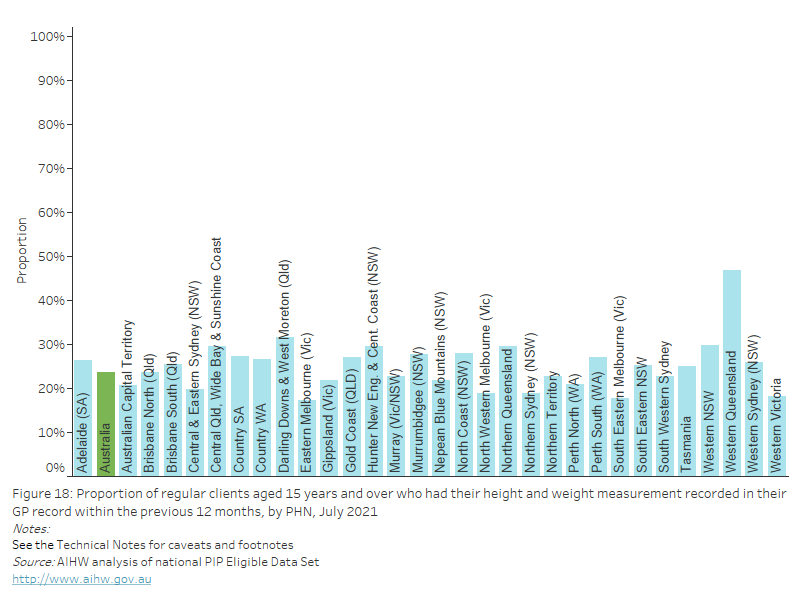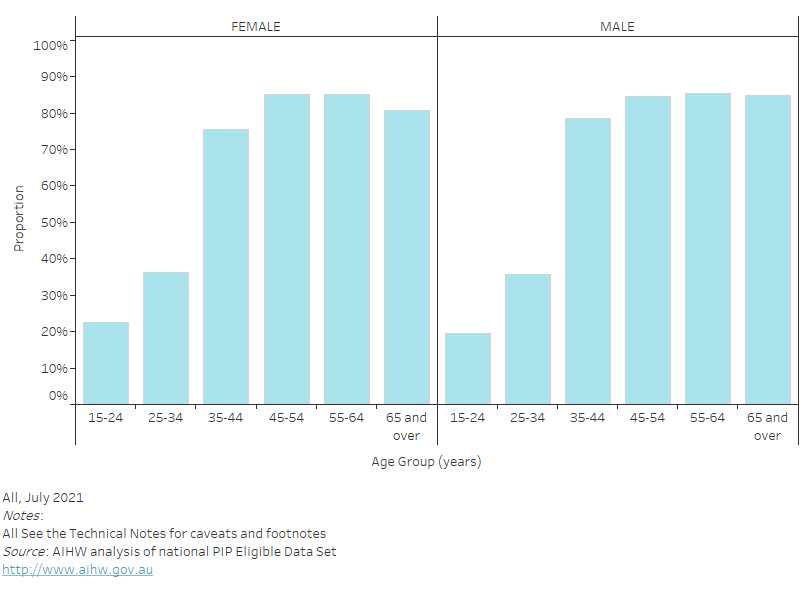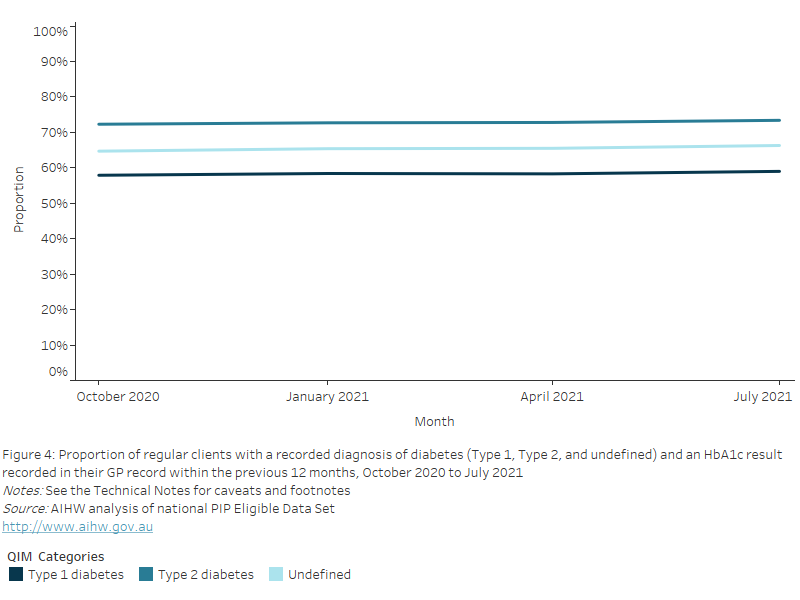QIM 3: Proportion of regular clients with a current height and weight classification recorded in their GP record and a derived BMI result
On this page
- Overview
- Proportion of regular clients with a weight classification recorded (3a)
- Proportion of regular clients with a weight classification result (3b)
In 2017-18, two thirds (67.0%) of Australian adults aged 18 years and over were overweight or obese (12.5 million people) (ABS 2018). Being overweight, obese or underweight is associated with higher rates of morbidity, and overweight and obesity is a major public health issue in Australia. Overweight and obesity are risk factors for Type 2 diabetes, cardiovascular disease, hypertension, osteoarthritis, some cancers, and gallbladder disease. Being overweight or obese is also associated with certain psychosocial problems, functional limitations, and disabilities. On the other hand, being underweight may cause malnourishment and lead to compromised immune function, respiratory disease, digestive diseases, cancer, and osteoporosis.
Other sources of relevant data
Data on measured height, weight and BMI are captured in the National Health Survey (NHS) conducted by the Australian Bureau of Statistics (ABS).
This indicator contains two parts, assessing the proportion of regular clients 15 years of age and older who:
- QIM 3a - had a height and weight measurement recorded in their GP record within the previous 12 months, from which a Body Mass Index (BMI) was derived
- QIM 3b - had their BMI classified as either underweight, healthy, overweight, or obese derived from the current height and weight recorded in their GP record.
QIM 3a – Proportion of regular clients aged 15 years and over whose height and weight have been recorded
Regional proportions
As of July 2021, nationally, 23.6% of regular clients aged 15 years and over had their height and weight measurements recorded in their GP record within the previous 12 months. This varied from 17.2% to 46.9% across PHNs.
Figure 18: Proportion of regular clients aged 15 years and over who had their height and weight measurement recorded in their GP record within the previous 12 months, by PHN, July 2021
Figure 18: Proportion of regular clients aged 15 years and over with an height and weight measurement recorded in their GP record within the previous 12 months, by PHN, July 2021

For clients aged 15-24 years, the BMI is included only if both the height and weight measurement have been recorded in their GP record in the previous 12 months. For those aged 25 years and over, the BMI is included in these data if the height measurement has been recorded since the client turned 25 years of age, and if the weight measurement has also been recorded in the GP record within the previous 12 months.
Proportion of regular clients aged 15 years and over whose height and weight have been recorded by age and sex
As of July 2021, nationally, the proportion of regular clients who had their height and weight recorded in their GP record in the previous 12 months, increased with age and was:
- highest in the 65 years and over age group for both females (33.8%) and males (34.5%).
- lowest in the 15–24 years age group for both females (16.1%) and males (10.7%), noting the different requirement for this age group that both height and weight be recorded in the previous 12 months.
Figure 19: Proportion of regular clients aged 15 years and over who had their height and weight recorded in their GP record within the previous 12 months, by age and sex, July 2021
Figure 19: Proportion of regular clients aged 15 years and over with height and weight recorded in their GP record within the previous 12 months, by age and sex, July 2021

Nationally between October 2020 and July 2021, the proportion of regular clients aged 15 years and over with a height and weight recorded in their GP record within the previous 12 months remained constant at 22.6% and 23.6% respectively.
Figure 20: Proportion of regular clients aged 15 years and over who had their height and weight recorded in their GP record within the previous 12 months, October 2020 to July 2021
Figure 20: Proportion of regular clients aged 15 years and over who had their height and weight recorded in their GP record within the previous 12 months, October 2020 to July 2021

QIM 3b - Proportion of regular clients aged 15 years and over whose BMI status was classified as either underweight, healthy, overweight, or obese
Regional proportions
As of July 2021, nationally, 2.0% of regular clients aged 15 years and over who had their height and weight recorded in their GP record in the previous 12 months, were classified as having a BMI within the underweight range. This varied from 1.4% to 2.7% across PHNs.
Figure 21: Proportion of regular clients aged 15 years and over who had their height and weight recorded in their GP record within the previous 12 months, with a BMI classification as “underweight”, by PHN, July 2021
Figure 21: Proportion of regular clients aged 15 years and over who had their height and weight recorded in their GP record within the previous 12 months, with a BMI classification as “underweight”, by PHN, July 2021

As of July 2021, nationally, 25.8% of those regular clients aged 15 years and over who had their height and weight recorded in their GP record in the previous 12 months, were classified as having a BMI within the healthy range. This varied from 19.1% to 37.0% across PHNs.
Figure 22: Proportion of regular clients aged 15 years and over who had their height and weight recorded in their GP record within the previous 12 months, with a BMI classification of “healthy”, by PHN, July 2021
Figure 22: Proportion of regular clients aged 15 years and over who had their height and weight recorded in their GP record within the previous 12 months, with a BMI classification of “healthy”, by PHN, July 2021

As of July 2021, nationally, 32.5% of regular clients aged 15 years and over who had their height and weight recorded in their GP record in the previous 12 months, were classified as having a BMI within the overweight range. This varied from 29.1% to 35.0% across PHNs.
Figure 23: Proportion of regular clients aged 15 years and over who had their height and weight recorded in their GP record within the previous 12 months, with a BMI classification as “overweight”, by PHN, July 2021
Figure 23: Proportion of regular clients aged 15 years and over who had their height and weight recorded in their GP record within the previous 12 months, with a BMI classification as “overweight”, by PHN, July 2021

As of July 2021, nationally, 39.8% of regular clients aged 15 years and over who had their height and weight recorded in their GP record in the previous 12 months, were classified as having a BMI within the obese range. This varied from 25.2% to 49.0% across PHNs.
Figure 24: Proportion of regular clients aged 15 years and over who had their height and weight recorded in their GP record within the previous 12 months, with a BMI classification as “obese”, by PHN, July 2021
Figure 24: Proportion of regular clients aged 15 years and over who had their height and weight recorded in their GP record within the previous 12 months, with a BMI classification as “obese”, by PHN, July 2021

Nationally between October 2020 and July 2021, of those who had their height and weight recorded in their GP record within the previous 12 months:
- a BMI status of “underweight” remained constant at 2.1% and 2.0% respectively
- a BMI status of “healthy” remained constant at 26.1% and 25.8% respectively.
- a BMI status of “overweight” remained constant at 32.4% and 32.5%.
- a BMI status of “obese” remained constant at 39.4% and 39.8% respectively.
Figure 25: Proportion of regular clients aged 15 years and over who had their height and weight recorded in their GP record within the previous 12 months, by BMI classification, October 2020 to July 2021
Figure 25: Proportion of regular clients aged 15 years and over who had their height and weight recorded in their GP record within the previous 12 months, by BMI classification, October 2020 to July 2021

Proportion of regular clients aged 15 years and over whose BMI status was recorded in their GP record and classified as either underweight, healthy, overweight, or obese, by age and sex
As of July 2021, nationally, the proportion of regular clients with their height and weight recorded in their GP record in the previous 12 months, who were classified as having a BMI in the underweight range was:
- highest in the 15–24 years age group for both females (8.7%) and males (7.1%).
- lowest in the 45–54 years age group for females (1.4%).
- lowest in the 35-44 years and 45-54 years age groups for males (0.5%).
Figure 26: Proportion of regular clients aged 15 years and over who had their height and weight recorded in their GP record within the previous 12 months, with a BMI classification as “underweight”, by age and sex, July 2021
Figure 26: Proportion of regular clients aged 15 years and over who had their height and weight recorded in their GP record within the previous 12 months, with a BMI classification as “underweight”, by age and sex, July 2021

As of July 2021, nationally, the proportion of regular clients with their height and weight recorded in their GP record in the previous 12 months, who were classified as having a BMI in the healthy range was:
- highest in the 15–24 years age group for both females (46.7%) and males (45.6%)
- lowest in the 55–64 years age group for females (23.7%).
- lowest in the 45–54 years age group for males (15.5%).
Figure 27: Proportion of regular clients aged 15 years and over who had their height and weight recorded in their GP record within the previous 12 months, with a BMI classification as “healthy”, by age and sex, July 2021
Figure 27: Proportion of regular clients aged 15 years and over who had their height and weight recorded in their GP record within the previous 12 months, with a BMI classification as “healthy”, by age and sex, July 2021

As of July 2021, nationally, the proportion of regular clients with their height and weight recorded in their GP record in the previous 12 months, who were classified as having a BMI in the overweight range was:
- highest in the 65 years and over age group for both females (32.4%) and males (41.4%).
- lowest in the 15–24 years age group for both females (20.3%) and males (23.3%).
Figure 28: Proportion of regular clients aged 15 years and over who had their height and weight recorded in their GP record within the previous 12 months, with a BMI classification as “overweight”, by age and sex, July 2021
Figure 28: Proportion of regular clients aged 15 years and over who had their height and weight recorded in their GP record within the previous 12 months, with a BMI classification as “overweight”, by age and sex, July 2021

As of July 2021, nationally, the proportion of regular clients with their height and weight recorded in their GP record in the previous 12 months, who were classified as having a BMI in the obese range was:
- highest in the 45–54 years age group for both females (46.4%) and males (47.5%).
- lowest in the 15–24 years age group for both females (24.4%) and males (24.1%).
Figure 29: Proportion of regular clients aged 15 years and over who had their height and weight recorded in their GP record within the previous 12 months, with a BMI classification as “obese”, by age and sex, July 2021
Figure 29: Proportion of regular clients aged 15 years and over who had their height and weight recorded in their GP record within the previous 12 months, with a BMI classification as “obese”, by age and sex, July 2021

QIM 3a: weight classification recorded
- Clients aged between 15 and 24 years are included if both the height and weight measurement have been recorded in the previous 12 months
- Clients aged 25 years and over are included if height has been recorded since the client turned 25 years of age and a weight has been recorded within the previous 12 months.
- Results arising from measurements conducted outside of the service that are known and recorded by the service are included in the measure.
QIM 3b: weight classification result
- Includes only those clients with a record of weight classification derived from a record of height and weight as defined in the numerator of QIM 03a.
- The combined categories of Underweight, Healthy, Overweight, Obese were used to define the total QIM 3b denominator.
- If the client had their BMI recorded more than once within the previous 12 months, only the most recently recorded result is included in this measure.
- Clients are excluded from the measure if they are 18 or older and either shorter than 0.914 or taller than 2.108 metres; or refused measurement.
ABS (Australian Bureau of Statistics) 2018. National Health Survey: first results, 2017–18. ABS cat. no. 4324.0.55.001. Canberra: ABS. Viewed 12 August 2021.


